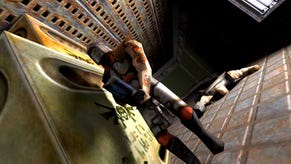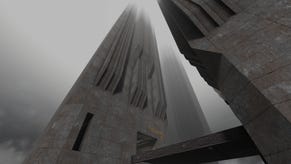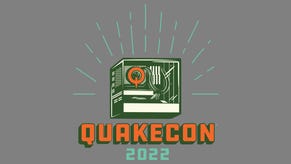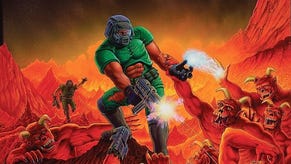Quake Renaissance: where is Quake now, and how did it get here?
Enter the war room
Everyone's heard of Quake. In 1996 it popularized "true 3D" level design, team multiplayer, the rocket jump, and even mouse look. Nine Inch Nails' subtle in-game soundtrack is still a high point in video game music. Source Engine games like Apex Legends use fancy upgrades of Quake's original movement code, and the internet recently shat itself when it realized Half-Life: Alyx still uses Quake's light flickering presets.
Quake is everywhere. Everyone's heard of Quake. But does anyone care?
A couple years ago, I sure didn't. I thought it was just a more boring, less colorful Doom. But then I learned about its difficult history, a fascinating mess of cursed magic. Despite its success and influence, Quake couldn't escape Doom's shadow, just barely held together, and eventually caused half of id Software to leave.
Doom's success left the company under heavy pressure for a follow-up. For a year, lead programmer John Carmack and lead designer John Romero kept changing directions, forcing people to redo work repeatedly. Half the team thought they were making a fantasy adventure about a guy with a magic hammer. Then in one fateful team meeting in November 1995, an exhausted team decided they should just make another Doom-like FPS with sci-fi elements.
The certainty was a relief, but still disappointing. They hadn't set out to make another sci-fi shooter. Most of Romero's levels were dark, medieval "wizard" themed. Level designer Sandy Petersen pushed for Lovecraft-inspired elements. Artists Kevin Cloud and Adrian Carmack (no relation to John) had spent a year painting Mesoamerican-themed "Aztec" textures, but discarded everything after level designer American McGee didn't want to use them. ("... they were so BROWN", McGee said in a 2011 interview.)
But as long as John Carmack and programmers Michael Abrash and John Cash could nerd out on engineering the most advanced 3D game engine the world had ever seen, maybe it didn't matter if Quake was a Doom clone. So id Software hired a Doom modder named Tim Willits, moved everyone into a single open plan office dubbed "the war room", and hunkered down into a marathon crunch, working 7 days a week for 7 months.

Romero triaged the project into four single player episodes, each led by a different level designer. Episode 1 features Willits' tidy castle levels, Episode 2 has Romero's clockwork wizard lairs, Episode 3 holds McGee's metal viking lava tombs, and Episode 4 trembles with Petersen's disorienting eldritch labyrinths. While the whole project was a dense collaboration where everyone did everything (e.g. McGee did much of the sound design), Quake especially empowered level designers with strong auteur control over the game experience, in a way that almost never happens in the games industry today.
On June 22, 1996, after a long and draining crunch, id Software finally released Quake: a strange mix of sci-fi lasers, nail guns, eyeless horrors, haunted castles, elder gods, and alternate dimensions. And it somehow worked, earning strong sales and reviews.
But as with all supposed crunch success stories, the human cost was heavy. Soon after Quake's release, more than half of the original dev team weren't working at id anymore. The design team shattered: Romero famously co-founded Ion Storm to make Daikatana with some ex-id devs. McGee's long-stewing firing led to the fondly remembered American McGee's Alice. Petersen fell into a deep depression, then moved to Ensemble Studios and hired many ex-id developers. "Quake is what killed the old id Software", Petersen said in a retrospective video.
More recently, Quake's toll has bubbled back to the surface, all around one person. In 2017, Willits bafflingly claimed to have invented the multiplayer-only map while working on Quake, prompting a detailed rebuttal by Romero who argued that the Doom community deserved the credit. Former id developers unanimously supported Romero over Willits. McGee even called Willits a "serial credit-thief", before posting a longer statment on Facebook where he called Willits' claim "easily refuted".
Another sad corollary is the work of Theresa Chasar, Willits' sister. Willits' "Raven" Doom maps were co-authored with Chasar. She also collaborated with Willits on MAP01 "Attack" in Doom 2 Master Levels, and was the original designer on map e4m5 "They Will Repent" in Ultimate Doom. id hired Willits, and not Chasar, and it seems that some Doom fans just casually forgot Chasar's co-authorship (it's something which Willits himself doesn't mention in this 1998 interview). Chasar's last known link to the games industry was in Doom 3 - lead designer: Tim Willits - where you meet an NPC named Theresa Chasar, and then seconds later a monster bursts out of her face. Weird apology, but OK.
Petersen won't even speak Willits' name aloud. In a July 2021 video log he told a story about a thinly-veiled "snake" who purposely lied to McGee to promote their own career. While Romero has lovingly corrected Petersen's hazy memory in the past, this doesn't seem like the type of thing someone would remember completely wrong. McGee doesn't remember the exact events but agreed that "what [Willits] wanted was to be the main guy in control. He was incredibly ambitious and cared not for how he moved up, only that he moved up."
After Quake 1, Willits basically controlled the Quake series until his departure in 2019, with initially promising but now rather mixed results.

The 1997 sequel Quake 2 was a competent sci-fi shooter that originally wasn't even intended to be a Quake game; today we fondly remember it more for multiplayer mods like the Hong Kong blood opera mod Action Quake 2 or prop hunt pioneer CrateDM. The 1999 follow-up Quake 3 Arena learned from these mods and went all-in on multiplayer, becoming a popular proto-esport and LAN mainstay in heated rivalry with Unreal Tournament.
... Until the early 2000s, that is, when arena shooters suddenly felt old-fashioned compared to the tide of military realism from Counter-Strike and a dozen World War II shooters. This seismic shift in gamer tastes prompted id to shake things up and license Quake to Activision, who then tasked two non-id studios with making Quake games.
In 2005, Raven Software's Quake 4 added some squad shooting and vehicle setpieces to a Doom 3 base, but strained under a tight schedule and complex custody with id Software and Activision. (The official "Quake Collection" bundle on Steam omits Quake 4 entirely, as if it never happened. Rude.) Then Splash Damage's 2007 team shooter Enemy Territory: Quake Wars staged some colossal Halo-like Tribes-y army battles. It too failed to find an audience, even though it was actually pretty good.

This last decade of Quake has felt confusing or, at worst, desperate. In 2010, Quake Live was a troubled esports-focused rerelease of Quake 3 that bounced between a free-to-play ad-supported browser plugin, to a strange subscription model in 2012, to a now neglected retail standalone on Steam by 2015. (It's still not a bad game, it's Quake 3.)
And since 2017 we've had Quake Champions, another free-to-play remake of Quake 3 but this time with fully remastered graphics and Overwatch-style character abilities, as well as the now-requisite loot box / battle pass economy. (It's still not a bad game, it's Quake 3.) On a good day, Quake Champions ranks as maybe the 500th most played game on Steam. Again, not bad at all for a 4 year old multiplayer arena shooter, but still disappointing for those who remember Quake's golden age.
What the hell happened? Quake used to feel like the unassailable vanguard of the entire FPS genre, or even the entire PC game industry at large. And now id Software have spent the past decade remaking Quake 3, twice. Despite its name, Quake is barely moving.

Yet it's never been a better time for Quake to become relevant again. The shooter audience is turning against Half-Life's slow storytelling, Counter-Strike's bland military realism, and Call Of Duty's subsequent merger of both. 1990s style retro shooters are newly popular. id Software have already revived Doom in a big way. Doom (2016) and Doom Eternal certainly celebrate the ethos of the original, to wide praise and success. However, the advanced graphics tech doesn't quite evoke the retro counter-culture feel.
Instead, look to the indie "boomer shooters", like the upcoming Quake-ish Hexen-likes Wrath and Graven, funded by a reanimated 3D Realms (reborn in 2014 as a Danish indie publisher). The early access Prodeus by Bounding Box Software promises "infinite blood" as well as a "mix of high-quality 3D art and retro rendering techniques." And New Blood Interactive's retro shooter trifecta Dusk, Amid Evil, and Ultrakill meld retro sensibilities with proper pixelated low poly homage. According to CEO of New Blood Interactive Dave Oshry, that means "fast, fun movement and mechanics, old-school hand-crafted level design, and big fucking guns."
Even the boomer shooter devs wonder why Quake hasn't returned yet. "Quake gave us everything," says Oshry. "It's the BLUEPRINT for a proper first person shooter with designs that have rippled throughout video games TO THIS DAY [...] I think what most people - at least people we know - want today is a DOOM 2016 style reboot of the first Quake. And I agree."

But making Quake Eternal today means invoking the original magic that haunts us from 1996: a tragic arc of free experimentation, then a guilty retreat, followed by a punishing crunch and painful fracture - punctuated by a fateful hire which may well have denied a woman a career in games. Unfortunately, Quake's cursed magic feels very contemporary.
Was all this bad blood and suffering worth a video game? As great as games are, the answer is always no. But maybe there's a way to fix Quake. The still-active Quake modding community has spent 25 years rethinking and reinventing everything, including themselves. To them, Quake is still here, and it never left.
NEXT TIME: part 2, the Quake modding community renaissance 25 years in the making.
Header render by Ben Hale








